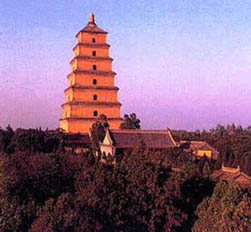 The Wild Goose Pagoda is situated at the Benevolence Temple (Ci?En Si), 1 kilometer to the south of Xian City, Shaanxi Province. The temple was originally known as Wulou Temple (literally no leaking ) in the Sui dynasty. In the 21st year (647) of Emperor Zhenguan rein of Tang dynasty, Prince Li Zhi (who later succeeded to the thrown as Emperor Gaozhong) reconstructed the Temple into Grand Benevolence Temple in commemoration of his of his mother Empress Wan De.
The Wild Goose Pagoda is situated at the Benevolence Temple (Ci?En Si), 1 kilometer to the south of Xian City, Shaanxi Province. The temple was originally known as Wulou Temple (literally no leaking ) in the Sui dynasty. In the 21st year (647) of Emperor Zhenguan rein of Tang dynasty, Prince Li Zhi (who later succeeded to the thrown as Emperor Gaozhong) reconstructed the Temple into Grand Benevolence Temple in commemoration of his of his mother Empress Wan De.
When Xuanzhuang, the Tang Monk, after acquiring the scriptures of Buddhism from India, returned to his motherland, he was lodged in the grand Benevolence Temple for the translation of the scriptures. In the 3rd year of Emperor Yongwei's rein of the Tang Dynasty, the Pagoda was built after the style of the Western Regions for the storage of the translation version of Buddhist scriptures. It was a five storeyed building at the beginning and the built into 7 storeys when the Empress Wuzetian was in power. The Pagoda is square in shape, 64 meters high with spiral staircase leading up to the top. There are structural design and Bodhisattva image delicately carved on the lintels on four sides. At the lower part of the Pagoda are two stone tablets on which are engraved Preface of the Holy Teaching and the Narration Record of the Holy Teaching by Chu Suiliang, the calligrapher of the Tang dynasty and on the brim of the stone tablets are relief sculptures of musicians and dancers.
Xuanzhuang (602-664) generally known as the Master of the Law (Tripitaka of Buddhism), customarily called Tang Monk was the famous scholar of Buddhism and great traveler and the Founder of Benevolence and Philanthropy of Buddhism.
Transportation: Bus 21, 29, 508, 610, 707 are accessible and getting off at Xiaoyanta bus station.
Ticket: Entrance fee 10 yuan; Pagoda admission: 20 yuan (US$1=8.3 yuan).
Open Time: 8:30--18:00
(china.org.cn February 20, 2003)
|

